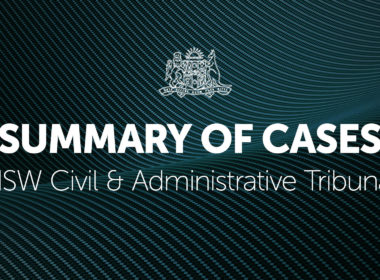You are a diligent and responsible solicitor who has worked many hours to assist your clients to win a case or achieve what they want in their retainers. However, for whatever reason, despite a job well done, your client refuses to pay. This is an unfortunate reality for many service providers and lawyers are no exception. All too often we have heard stories of clients who delay or refuse to pay solicitors for their work.
It is therefore worthwhile knowing that a lien can be an effective recourse for practitioners who find themselves in such circumstances. A lien is a security interest which gives one person the right to retain possession over another person’s property until a debt is paid or other obligations are satisfied.[1]
Liens can therefore provide solicitors them with to ensure reasonable compensation for services provided.
Having a sound understanding how liens operate will better enable you to provide effective legal services. The Office of the NSW Legal Services Commissioner, along with the Law Society of NSW, Lawcover and College of Law, have identified liens and file transfers as one of the 10 areas considered to be fundamental to ensure compliance with the Legal Profession Uniform Law and other professional obligations.[2]
It is therefore important to understand about the operation of liens even if you never plan on exercising a lien. A lien may be a hinderance for you and your client to receive relevant files and documents in situations where, say, the client wants to retain you in place of another lawyer. Having familiarity with the nature and limitations of a solicitor’s lien will place you in good stead to best defend your client’s interest when they are faced with a claim of lien by another solicitor.
There are two types of liens:
- possessory lien (also known as a ‘general lien’); and
- Equitable liens (sometimes described as a ‘fruits of actions’ lien).
Possessory liens
A possessory lien is the right of a solicitor to retain any client’s property as security for the payment of their costs. The possessory lien can attach to any item of the property that belongs to the client and in the possession of the solicitor.
The solicitor’s possession of the document or property must be referrable to the solicitor-client relationship[3]. For example, if a solicitor receives title deeds to a client’s property because the mortgagee (who is not the client) deposited them with the solicitor, the solicitor would not be able to exercise a lien over those deeds. This is because the solicitor did not receive the title deeds as part of their solicitor- client relationship.
Nature of possessory liens
With possessory liens, the solicitor only has the right to possess the client’s property until the client pays the outstanding bill. It does not transfer ownership of the client’s property to the solicitor.[4] It follows that, with possessory liens, the solicitor can retain the client’s property but cannot sell or encumber the client’s property. [5]
Further, this type of lien only extends to costs and disbursements incurred by the solicitor for his client which can be subject to costs assessment. Should a costs dispute arise between the solicitor and the client, the lien does not extend to the costs of the costs assessment as such costs are incurred for the solicitor’s own benefit.[6]
Items that can be covered by a possessory lien
Property over which a possessory lien can hold include documents and money in the trust account[7]. Notably however, a possessory lien cannot attach to a client’s will[8] or other documents or property that are held by the solicitor for a specific purpose, nor can a possessory lien extend to third parties.
For example, in Elders Rural Finance Limited v Tapp (1993) 113 FLR 351 (Elders),[9] Martin CJ commented that, “[a possessory lien]… cannot be asserted against third parties who would be entitled to production as against the client.”
In Elders, the plaintiffs and the defendants subpoenaed the former solicitors of a deceased person, Charles Tapp. However, the solicitors to whom the subpoenas had been addressed sought orders to set aside the subpoenas or, in the alternative, directions made with respect to the subpoenas. The deceased owed money to the solicitors on account of their professional fees (some billed, some not) and, accordingly, asserted a lien over some of the subpoenaed documents.
Elders illustrates a solicitor is required to obey a subpoena to produce, namely, to produce documents to the court, the property of a deceased, in litigation proceedings. on the basis that those documents were ones that the [deceased] client would not ordinarily be entitled.[10]
While a solicitor may be entitled to assert and protect a lien, bear in mind that the court’s protection of that asserted lien will be secondary to its priority to ensure the administration of justice.[11]
This means that a court may order documents to be produced to the court, despite the existence of a lien over certain documents, particularly in litigation proceedings where their production is in the interests of justice. This situation tends to arise where there has been a change of solicitors preceding litigation.
Impact on the lien upon change of solicitors
The most common issue arising on liens is when there is a change of solicitors. Often, how the issue is resolved depends on who terminates the retainer.
If the client terminates the retainer then the solicitor’s lien would subsist until there is full payment of the costs by the client, unless the termination is due to the solicitor’s misconduct.[12]
If the solicitor terminates the retainer without good cause, the solicitor’s lien comes to an end.[13] If the solicitor terminates the retainer for good cause, the solicitor’s lien continues.
If the retainer imposes an obligation on the client to pay at certain intervals but the client fails to pay, the solicitor arguably has just cause to terminate the retainer after giving the client a reasonable opportunity to rectify the breach. In such circumstances the solicitor would retain their right to claim a possessory lien.
Rule 15 of the Legal Profession Uniform Law Australian Solicitors’ Conduct Rules provides for the possibility of releasing client files to the new solicitor while protecting the security of the previous solicitor. Rule 15.2 provides that the solicitor’s claiming to exercise the lien must deliver the documents to the client upon receiving reasonable security for the unpaid costs.
The solicitor may also release the file to the new solicitor if both solicitors and the client enter into a tripartite agreement. The agreement would provide that the new solicitor agrees to pay the former solicitor their outstanding costs upon receipt of money from the other party in the proceedings. [15]
Equitable or fruits of the action lien
Nature of the equitable/fruit of the actions lien
The purpose of equitable liens is to prevent the client from unfairly deflecting funds away from the solicitor.[16] In some cases, solicitors can claim an equitable right to claim their costs over the judgment or settlement sum if the solicitor’s work is instrumental in enabling the client to receive an awarded sum.
Equitable liens are a form of security that arises due to the subsistence of equitable rights. These liens assist solicitors in situations where they have a legitimate claim to their costs because, for example, they generated for the client an entitlement to a fund arising out of a judgement, award or compromise.
The solicitor may need to approach the court for a court order to enforce the equitable lien over that fund. The court order is necessary because a solicitor has no common law title over the client’s right to receive money from a judgment or settlement.[17]
Equitable liens differ from possessory liens as the former can arise even where no document or property has come into the solicitor’s possession. These liens are similar to an equitable assignment of the client’s money to the solicitor for their costs.
Principles for the equitable/fruits of the action lien
There are a number of principles that apply to equitable liens.[20] These are:
(a) Equitable liens can be held over money recovered through litigation and settlement;
(b) The solicitor’s right exists over both the amount of a judgment in favour of the client and the amount of an order for costs in favour of the client;
(c) To successfully claim an equitable lien, the client does not need to be current at the time that the money was recovered;
(d) For the right to arise it must be shown that there is a sufficient causal link between solicitor’s services and the recovery of the fund of money;
(e) The quantum of money for which the solicitor has the equitable right is the amount which is properly owing to the solicitor by the client, whether that amount be ascertained by taxation of a bill of costs, or assessment, or pursuant to a costs agreement. In relation to those situations where taxation is necessary to ascertain the quantum owing to the solicitor, the solicitor’s right exists in the fund prior to the occurrence of the taxation;
(f) The solicitor’s equitable right exists prior to the court being asked to intervene to protect it; it arises immediately upon the recovery of monies through the exertions of the solicitor. If the lien is over the proceeds of an order for costs, it comes into existence at the time of making of that order for cost.
If the lien is over the proceeds of a settlement, it arises when the settlement agreement is entered into.
(g) The right of the solicitor is one which the solicitor can enforce against the client, entitling the solicitor to an injunction to prevent the payment of the fund to the client without notice to the solicitor until such time as the quantum of the solicitor’s entitlement to be paid from the fund is ascertained.
Notice to the party who has to pay money or a settlement sum to the client
As stated above, solicitors who exert an equitable lien have an equitable right to be paid their costs from the judgment or settlement sum payable to the client.
If the solicitor gives notice of their equitable lien to the person who is liable to pay the judgment sum to the client, only the solicitor (and not the client) .[21]
Application to court for the protection of costs of the solicitors
As the solicitor claiming the equitable lien does not have control over the proceeds of the litigation/settlement sum, the solicitor is usually required to apply for assistance from the Court to exercise their lien.
Such a solicitor would usually make an interlocutory application and provide the court with a detailed affidavit with:
- the nature and period of the retainer;
- a brief description of the work undertaken on the (former) client’s behalf;
- the costs rendered to the (former) client, and the amount of unpaid costs; and
- evidence linking the work undertaken to the result of the litigation.[22]
The application itself is made to the Supreme Court of New South Wales (usually to the Equity Division, though it can be made to the Common Law Division) by summons and affidavit. Solicitors should prepare short minutes of order for short service of the material relied upon.[23]
Liens have been a recognised property right since Roman times. Arguably, their longevity is in part due to their recognised effectiveness and deep-rooted history as part of our justice system. Having a good understanding on the nature and operation of liens is therefore invaluable to any legal practice.
The NSW Law Society’s Professional Support Unit provides free and confidential guidance to legal practitioners about their compliance, costs and ethical obligations under the Uniform Law.
Costs: costs@lawsociety.com.au or (02) 9926 0116
Ethics: ethics@lawsociety.com.au or (02) 9926 0114
Regulatory compliance: regulatory.compliance@lawsociety.com.au or (02) 9926 0115
[1]LexisNexis Practical Guidance AU – Business- Commercial finance — essentials / Security interests in commercial financing transactions published by Lexis Nexis Australia
[2] Office of the NSW Legal Services Commissioner, ‘https://olsc.nsw.gov.au/for-the-profession/compliance/background.html
[3] Barrat v Gough-Thomas [1951] Ch 242- A solicitor cannot claim lien over the title deeds of a property for the costs incurred for an aborted sale of the property by the mortgagor if the title deeds were deposited with the solicitor by the mortgagee for safe custody and the solicitor acted for both the mortgagee and the mortgagor
[4] Johns v Law Society of NSW [1982] 2 NSWLR 1 at 20
[5] Coshott v Parker [2018] FCA 596
[6] Para 18,010.10 of Solicitors Manual by GE Dal Pont
[7] Section 144(2)(a) of the Legal Profession Uniform Law (NSW)
[8] Balch v Symes Turn &R. 87
[9] Elders Rural Finance Ltd v Tapp [1993] NTSC 44; 113 FLR 351 (21 June 1993) (austlii.edu.au)
[10] see also Andersen v Lockhart [1991] 1 Qd R 501 at 504 per Ryan J; Re Aveling Barford Ltd [1989] 1 WLR 360; [1988] 3 All ER 1019; and Re Hawkes; Ackerman v Lockhart [1898] 2 Ch 1 [ at 6-7] per Lindley MR.
[11] Relevantly, Sir John Stuart VC commented in O’Brien v. Lewis (1863) 4 Giff [at 398]; 66 ER at page 761, that ‘A solicitor’s lien is a right which is founded on the rules of [this] Court and on the principles of common sense’.
[12] Kyriackou v Martin {2014] VSC 122 [8}-[11]
[13] ibid
[14] ibid
[15] https://www.lawsociety.com.au/practising-law-in-NSW/ethics-and-compliance/costs/tripartite-deeds
14 Solicitors Manual by GE Dal Pont Chapter 19 Para 19,000
[16] Re Peak Hotels and Resorts Ltd (in liq) [2023] 1 WLR 342 ;[2023] Bus LR 191; [2022] UKSC 35 at [39] per Lord Kitchin.
[18] Solicitors Manual by GE Dal Pont Chapter 19 Para 19,0005.5; Bozon v Bolland (1839) 4 My & Cr 354 at 357; 41 ER 138 at 139 per Cottenham LC; Re a Barrister and Solicitor (1979) 40 FLR 26 at 39 (FC(ACT)); Color Point Pty Ltd v Markby’s Communication Group Pty Ltd (FCA, Weinberg J, 27 November 1998, unreported) at 23
[19] Solicitors Manual by GE Dal Pont Chapter 19 Para 19,0005.5
[20] For more information and further reading, see: Firth v Centrelink [2002] NSWSC 564 at 35 and Goldberg v Beckett [2015] NSW SC 1966 at 30
[21] Ex Parte Patience; Mackinson v The Minister [1940] NSWStRp 11; (1940) 40 SR (NSW) 96 at 100
[22] Solicitors Manual by GE Dal Pont Chapter 19 Para 19,015.10 and D H Katter, “A Solicitor’s Enforcement Right over Settlement Funds” (August 2002) 22 Proctor 19 at 22
[23] “Getting in on the ‘fruits of the action’: the power of the equitable lien” by Michelle Castle and Andrew Bailey LSJ online 01 August 2018




